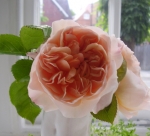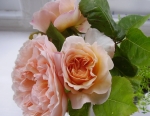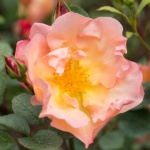 I’ve been looking at roses this week, picking one to buy, as well as picking some from the garden. My garden rose has short stems, so I found a porcelain piece I made at college, that’s the perfect vase: holding the blooms up, plenty of length to keep them fresh for longer. Using it as a vase would be anathema to my college tutors, of course: we were trying to use art, craft, whatever, to make people think, not be useful in a more direct way.
I’ve been looking at roses this week, picking one to buy, as well as picking some from the garden. My garden rose has short stems, so I found a porcelain piece I made at college, that’s the perfect vase: holding the blooms up, plenty of length to keep them fresh for longer. Using it as a vase would be anathema to my college tutors, of course: we were trying to use art, craft, whatever, to make people think, not be useful in a more direct way.
 The rose is from David Austin Roses. He’s such an example of art outside the art world. There’s a great respect for history, yet the continuous development of radical new forms and concepts within his field. Yes, literally (sorry, had to make the joke. What’s the definition of a farmer? A man out standing in his own field.)
The rose is from David Austin Roses. He’s such an example of art outside the art world. There’s a great respect for history, yet the continuous development of radical new forms and concepts within his field. Yes, literally (sorry, had to make the joke. What’s the definition of a farmer? A man out standing in his own field.)
 I visited the David Austin rose gardens maybe fifteen years ago. The experience of walking through it, the smells, the variety of forms and colours, the beauty of the roses as a mass and in close up stays with me even now. It’s something that doesn’t translate easily though, into print or into digital.
I visited the David Austin rose gardens maybe fifteen years ago. The experience of walking through it, the smells, the variety of forms and colours, the beauty of the roses as a mass and in close up stays with me even now. It’s something that doesn’t translate easily though, into print or into digital.
One flower, the Windflower, had a beautiful habit. The shape of the bush, and the relationship of the flowers to the space above it, was so striking I still remember it today. Austin notes this habit in his catalogue, but it’s something that can’t be put over in a static image: the picture of the flowers doesn’t convey that particular quality. You have to be in the space with it, move around it: experience it at macro and micro scales.

There’s an different relationship with time too, one that makes me think of TJ Clark’s ‘A Sight of Death’ (Guardian review, and a previous post) where he talks about the experience of revisiting a Poussin painting, day after day. To me, this is like seeing a plant bloom: a bud, a half-opened flower, a full bloom; but more: the growth, maturity and death of a plant. It’s one instance of the art-work that is ‘Windflower’. Like having a perfect copy of the Poussin that develops in front of you then fades away.
In 1945 Merleau-Ponty theorised about this ‘phenomenological’ aspect to art, the need for the body to be involved – so central in most craft. For him, I sense, therefore I am, before ‘I think therefore I am’. Like Carsten Holler’s giant slides in the Tate in 2005. (They’re coming back, by the way, to the Hayward.) Or the Pavilions at the Serpentine. Installation art is often about our relationship with objects in space, their relationships with each other. My experience in Austin’s garden was the same kind of experience, I think, just not framed as art.
PS. here’s a few roses on my shortlist. Any recommendations?
- Windflower
- Scarborough Fair
- Fighting Temeraire




Gertrude Jekyll!
LikeLike
Hmm – it does look lovely. And ‘a perfectly balanced old rose scent’, too!
LikeLike
Rambling Rector… my mother’s favorite.
LikeLike
Apparently is has lovely hips, too. I made Rosehip syryp (from hedgerow hips) a while ago, Delicious!
LikeLiked by 1 person